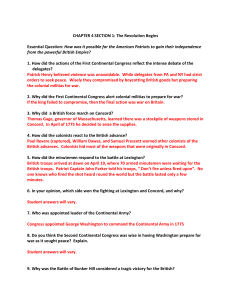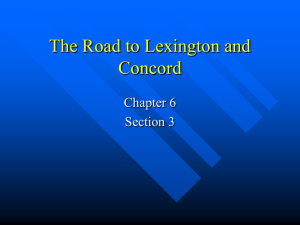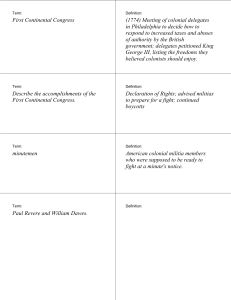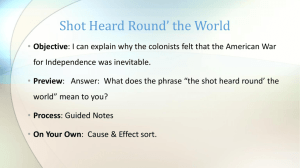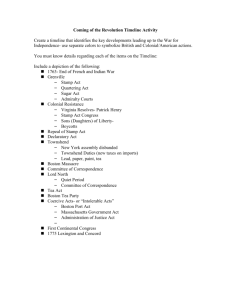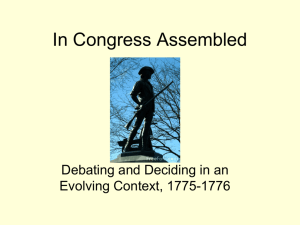Lexington, Massachusetts
advertisement
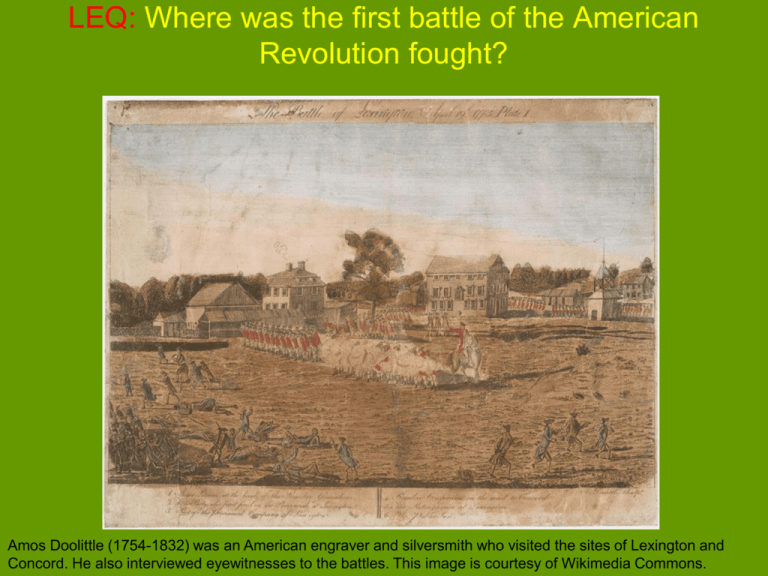
LEQ: Where was the first battle of the American Revolution fought? Amos Doolittle (1754-1832) was an American engraver and silversmith who visited the sites of Lexington and Concord. He also interviewed eyewitnesses to the battles. This image is courtesy of Wikimedia Commons. LEQ: Where was the first battle of the American Revolution fought? Lexington, Massachusetts Amos Doolittle (1754-1832) was an American engraver and silversmith who visited the sites of Lexington and Concord. He also interviewed eyewitnesses to the battles. This image is courtesy of Wikimedia Commons. The American Revolution Begins Some events that occurred in the American Revolution included clockwise from top left to right: Battle of Bunker Hill, the death of General Montgomery at the Battle of Quebec, the Battle of Cowpens, and the Battle of Cape St. Vincent. This image is courtesy of Wikimedia Commons. LEQ: Where was the first battle of the American Revolution fought? Amos Doolittle (1754-1832) was an American engraver and silversmith who visited the sites of Lexington and Concord. He also interviewed eyewitnesses to the battles. This image is courtesy of Wikimedia Commons. LEQ: Where was the first battle of the American Revolution fought? Lexington, Massachusetts Amos Doolittle (1754-1832) was an American engraver and silversmith who visited the sites of Lexington and Concord. He also interviewed eyewitnesses to the battles. This image is courtesy of Wikimedia Commons. Punishing the Colonies Following the Boston Tea Party the British Parliament passed a series of four laws called the Coercive Acts, also known as the Intolerable Acts which were meant to force the colonists to do what Parliament wished. This engraving by Franz Habermann shows Boston and its harbor. Two ships are at anchor, and British soldiers and other men are working. It is courtesy of the Library of Congress. One of the Coercive Acts closed the port of Boston until payment was made for the tea. “The Destruction of Tea at Boston Harbor” was painted in 1846 by Nathanial Currier. It depicts some colonists disguised as Native Americans. This image is courtesy of Wikimedia Commons. Another of the Coercive Acts provided that British troops could be quartered in any town in the colonies, although in buildings that were unoccupied. This is a drawing of a soldier in the 29th Regiment of the British Army. The 29th’s Grenadier Company fired on civilians during the “Boston Massacre.” This image is courtesy of Wikimedia Commons. Colonists Take Charge The words “Give me liberty, or give me Death!” were delivered by Patrick Henry before the Virginia Assembly at Richmond, Virginia on March 23, 1775. This is courtesy of the Library of Congress. The Committees of Correspondence united the colonists more than ever before. This painting shows a meeting in Belmont Hall located in Smyrna, Delaware. Political meetings were held in this house from 1772 until the adoption of the Federal Constitution in 1789. This image is courtesy of belmonthall.org. A call went out for delegates from each colony to meet and discuss their common concerns. Most of the writing during the Colonial period was created by quill pens made from a moulted flight feather of a large bird, such as a goose. The quills were dipped in a bottle of ink. This image by Pearson Scott Foresman is courtesy of Wikimedia Commons. In 1774, 56 delegates from every colony except Georgia met in Philadelphia to form what became known as the First Continental Congress. The First Continental Congress met in Carpenter’s Hall, which is shown at the end of this street. This image was taken facing southwest by Robert Housch on July 30, 2009. The First Continental Congress Carpenter’s Hall was a new structure, completed in 1774 before the First Continental Congress met here near the end of that year. It was a meeting place of a group of Philadelphia master builders known as the Carpenters’ Company. The Carpenters banded together to set architectural standards and prices. They also provided aid for family members if needed. This image by Robert Housch was taken facing northwest on July 30, 2009. Discussions were difficult because each colony had its own needs and viewpoints. When the First Continental Congress met, Carpenter’s Hall was very plainly furnished with yellow pine boards, simple moldings around the windows and doors, and untrimmed fireplaces. This image was taken by Robert Housch on July 30, 2009. The most outspoken criticisms of Parliament came from the colonies of Massachusetts and Virginia. The figures in the left foreground are from left to right, John Adams, Patrick Henry, and Samuel Adams. This is an artist’s conception of them meeting outside Carpenter’s Hall during the sessions of the First Continental Congress in the autumn of 1774. This image by Robert Housch was taken from the National Park Service wayside exhibit outside Carpenter’s Hall on July 30, 2009. The delegates approved Massachusetts’ plan for arming and training a militia. The Minute Man Statue in Lexington, Massachusetts depicts Captain John Parker, who was the leader of the Lexington militia. This image is courtesy of Wikimedia Commons. The Continental Congress Takes a Stand This drawing is titled “Delegates Leaving Carpenters’ Hall After a Session.” It was created by Henry Alexander Ogden (1856-1936), and is courtesy of the Library of Congress. The delegates of the Continental Congress issued a statement that they were entitled to “life, liberty, and property.” This image by French engraver Francois Godefroy (1743?-1819) is titled “Premiere Assemblee du Congres.” It depicts the First Continental Congress in Carpenter’s Hall, Philadelphia, Pennsylvania in September, 1774. This image is courtesy of the Library of Congress. The statement went on to declare that the colonists would never give up one of these rights against their will. The delegates to the First Continental Congress placed their signatures on a document titled the “Continental Association.” They pledged not to trade with Britain until their rights were restored. George Washington’s signature is near the bottom of the document. This image was taken by Robert Housch on July 30, 2009. The Congress insisted that they, and the people they represented, were loyal subjects of George III. King George III of the United Kingdom (1738-1820) is shown in a General Officer’s coat in 1771. It was painted by Johann Zoffany (1733-1810). This image is courtesy of Wikimedia Commons. Moving Toward a Crisis American colonists confront British soldiers in a painting by E. Percy Moran (1862-1935) titled “The First Resistance.” This image is courtesy of the Library of Congress. During the winter of 1774, Parliament debated ways to respond to the colonists. From the 1600s to the early 1800s the British Parliament met in St. Stephens Chapel. This is the House of Commons circa 1710. This image is courtesy of Wikimedia Commons. William Pitt (the Younger) argued that British troops should be withdrawn from America. William Pitt (1759-1806) became the youngest Prime Minister of Great Britain in 1783 at the age of 24. Here he argues before the House of Commons in 1793 concerning the outbreak of the war with France. This image by Karl Anton Hickel is courtesy of Wikimedia Commons. King George III and his advisers, however, would not listen. They saw the colonies as disobedient children. The event pictured in this cartoon took place after the American Revolution. King George III (on the left, his face hidden by the pillar) is removing from his presence those who wanted to give equal rights to Catholics. This image by James Gilray was created in 1807. It is courtesy of the Library of Congress. LEQ: Where was fought the first battle of the American Revolution fought? Amos Doolittle (1754-1832) was an American engraver and silversmith who visited the sites of Lexington and Concord. He also interviewed eyewitnesses to the battles. This image is courtesy of Wikimedia Commons. LEQ: Where was the first battle of the American Revolution fought? Lexington, Massachusetts Amos Doolittle (1754-1832) was an American engraver and silversmith who visited the sites of Lexington and Concord. He also interviewed eyewitnesses to the battles. This image is courtesy of Wikimedia Commons. The Colonists Take Arms The British Land Pattern Musket, was commonly referred to as the “Brown Bess.” This weapon, and various patterns based on the Brown Bess, was used from 1722-1838 by both the British Army and by the United States Army. This image is courtesy of Wikimedia Commons. Daily tensions between the colonists and British soldiers grew. This image shows an event that occurred well before the American Revolution. Civilians were not happy that soldiers were leaving Fort Frederica, Georgia. This image was taken in the Fort Frederica National Historic Site Visitor Center by Robert Housch circa April 23, 2011. The farmers and artisans in the militia, drilling on the village greens, were called Minutemen because they could be ready to fight at a minute’s notice. “The Minute Man” is a statue by Daniel Chester French erected in Concord, Massachusetts in 1875. This image is courtesy of Wikimedia Commons. In the Virginia House of Burgesses, Patrick Henry said: “…I know not what course others may take; but as for me, give me liberty or give me death!” When Patrick Henry spoke before the Virginia Assembly on March 23, 1775, they were meeting in St. John’s Church in Richmond, Virginia. This image is from Mara L. Pratt’s American’s Story for America’s Children published in 1901. A Warning for the Minutemen Samuel Prescott, Paul Revere, and William Dawes were the most famous riders who rode though the towns from Boston to Concord warning the local militia that the British would be marching through their area. There were also other backup riders whose names have been lost to history. This image is courtesy of the National Archives. American spies heard that British General Thomas Gage was sending soldiers to take the colonists’ supply of guns and gunpowder stored in Concord. General Thomas Gage served as commander-in-chief of British forces in North America from 1763-1775. This image was painted in 1788 by John Singleton Copley(1738-1815). It is courtesy of the Yale Center for British Art. The British planned to march from Boston to Concord. What the American spies didn’t know was would the British go all the way by land, or partly be water? Ahead of the British would be the Patriot riders such as Samuel Prescott, William Dawes, and Paul Revere warning the towns along the way. This map is oriented to the north, or is facing in the direction of north. Boston is on the far right or east. Concord is on the far left or west. It is approximately 20 miles from Boston to Concord. This image is courtesy of the National Park Service. Dr. Joseph Warren planned to flash one light from the North Church bell tower if the British were approaching by land and two lights if they were going by water. While Dr. Warren was in charge of the overall warning operation, he did not climb the steps to the steeple. Christ Church Sexton Robert Newman and Vestryman John Pulling carried and lit the lanterns. The steeple at the time of the Revolutionary War was destroyed by a fire in 1804. This image in 1882 shows the steeple constructed in 1807, but destroyed in 1954. It is courtesy of Wikimedia Commons. Spies informed Dr. Warren that at first the British would travel by water. Going by water meant the British soldiers would use boats to cross the Charles River instead of using the “Boston Neck” and going entirely by land. This image is courtesy of the National Park Service. Two lanterns were displayed in the church tower to inform riders who were supposed to warn the colonists. The signal was to be one lantern if the British were going by land, and two lanterns if they were using the water. This image is courtesy of the National Park Service. Immediately William Dawes, Samuel Prescott, Paul Revere and multiple “backup riders” jumped on their horses and galloped to towns along the expected marching route. There were backup riders because nobody knew which riders which get through or which ones would be arrested. Although there may have been as many as 40 riders warning the towns, Paul Revere has received the most publicity because of an 1861 poem by Henry Wadsworth Longfellow titled “The Midnight Ride of Paul Revere.” This image is from D. H. Montgomery’s The Beginner’s American History published in 1902. Although legend and a famous poem about the event has the riders such as Paul Revere yelling “The British are Coming!” most of the people in America considered themselves to be British and that wouldn’t make much sense. They might have shouted “the Regulars are coming!”or “the Redcoats are coming,” meaning the regular, full time soldiers in the British army, who wore red uniforms, not part time militiamen. The famous poem is called “The Midnight Ride of Paul Revere” by Henry Wadsworth Longfellow written in 1861. This image is courtesy of mssimonsays.weebly.com. The Battles of Lexington and Concord This image by Amos Doolittle (1754-1832) shows the British marching into Concord, Massachusetts on the morning of April 19, 1775. This image is courtesy of Wikimedia Commons. 700 British soldiers reached Lexington, a town on the way to Concord soon after dawn on April 19th. This photograph shows the green or public area in Lexington, Massachusetts where the Battle of Lexington was fought. This image, taken in 2007 is courtesy of Wikimedia Commons. Lexington is a little over half way from Boston to Concord. Concord is almost 20 miles from Boston. Lexington is approximately 14 miles from Boston. This image is courtesy of the National Park Service. To their surprise, about 70 Minutemen armed with weapons were waiting for them on Lexington Green. Lexington Militia Captain John Parker instructed his men,” Do not fire unless fired upon; but if they mean to have a war, let it begin here.” This image is courtesy of lexingtonminutemen.com. Someone fired a shot. Then, more shots were fired, and 8 colonists fell dead and 10 were wounded. The British redcoats continued on to Concord. The first shots of the Battle of Lexington are depicted in William Barnes Wollen’s (1857-1936) “The First Fight for Independence, Lexington Common, April 19, 1775.” He created it in 1910 and it is courtesy of Great Britain’s National Army Museum. It took approximately three hours for the British to march from Lexington to Concord. Lexington is almost halfway between Boston and Concord. This image is courtesy of the National Park Service. In Concord the British did not find the militia supplies for which they had been searching. While the British were searching Concord, the size of the colonial force in the surrounding area grew. This image shows Concord, Massachusetts in 1794. This image appeared in the July 1794 issue of The Massachusetts Magazine. This image is courtesy of common-place.org. At North Bridge, just outside of Concord, the colonial militia attacked and three redcoats and two minutemen were killed in a brief battle. This image by Amos Doolittle (1754-1832) shows the colonists attacking the British at Concord, Massachusetts’ North Bridge on the morning of April 19, 1775. This image is courtesy of Wikimedia Commons. The British decided to retreat back to Boston. The colonists would be waiting for them along the route of their march. This image by Amos Doolittle (1754-1832) shows the British entering Concord, Massachusetts on the morning of April 19, 1775. This image is courtesy of Wikimedia Commons. Crouched behind trees and stone walls, militia from multiple towns along the road to Boston fired at the British. At times the British were retreating very, very quickly. Unlike the Americans behind the stone wall in this picture, the militia did not have uniforms on April 19, 1775. This image is from Mara L. Pratt’s American’s Story for America’s Children published in 1901. Most of the British did make it back to Boston that night. This image by Amos Doolittle (1754-1832) shows the colonists at Lexington on the afternoon of April 19, 1775 attacking the British as 1000 British soldiers reinforced the British soldiers retreating from Concord. The British losses this day were 300 (73 killed, 174 wounded, and 53 missing). Patriot losses were 93 (49 killed, 39 wounded, and 5 missing). This image is courtesy of Wikimedia Commons. The Second Continental Congress The Second Continental Congress convened in Philadelphia with approximately 50 members, but each colony had only one vote. This image is courtesy of the Library of Congress. When the Second Continental Congress met in Philadelphia in May, 1775 events had dramatically changed. The Second Continental Congress met in Philadelphia’s Independence Hall, which was known at the time as the Pennsylvania State House on May 10, 1775, less than a month after the fighting at Lexington and Concord. This photograph was taken by Robert Housch, facing southwest on July 30, 2009. The congress chose George Washington to build a Continental Army. This image shows George Washington accepting his commission as Commander in Chief of the Continental Army from the Second Continental Congress. This image was painted in 1876 by Currier and Ives and is courtesy of the Library of Congress. In July 1775 the Congress sent the king an “Olive Branch Petition” hoping he would act to protect his loyal American subjects and remove British troops. The Olive Branch petition was adopted by the Second Continental Congress in July, 1775. This image is courtesy of the Library of Congress. LEQ: Where was the first battle of the American Revolution fought? Amos Doolittle (1754-1832) was an American engraver and silversmith who visited the sites of Lexington and Concord. He also interviewed eyewitnesses to the battles. This image is courtesy of Wikimedia Commons. LEQ: Where was the first battle of the American Revolution fought? Lexington, Massachusetts Amos Doolittle (1754-1832) was an American engraver and silversmith who visited the sites of Lexington and Concord. He also interviewed eyewitnesses to the battles. This image is courtesy of Wikimedia Commons.

